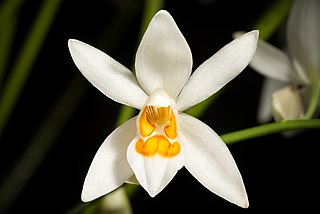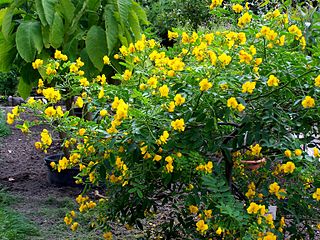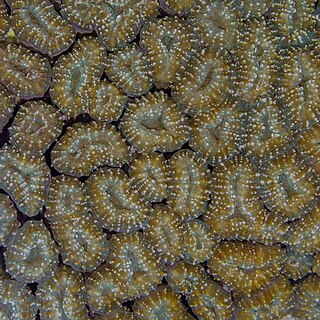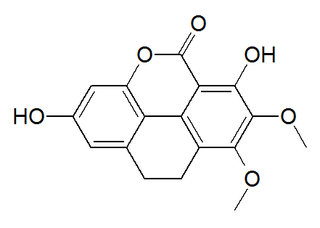
Ipomoea corymbosa is a species of morning glory, native throughout Latin America from Mexico as far south as Peru and widely naturalised elsewhere. Its common names include Christmasvine, Christmaspops, and snakeplant.

Coelogyne is a genus of over 200 sympodial epiphytes from the family Orchidaceae, distributed across India, China, Indonesia and the Fiji islands, with the main centers in Borneo, Sumatra and the Himalayas. They can be found from tropical lowland forests to montane rainforests. A few species grow as terrestrials or even as lithophytes in open, humid habitats. The genera BolborchisLindl., HologynePfitzer and PtychogynePfitzer are generally included here. The genus is abbreviated Coel. in trade journals.
Black orchid or Black Orchid may refer to:

Coelogyne nitida is a species of orchid in the Coelogyne genus.

Coelogyne pandurata is a species of orchid. It is found in Malaysia, Sumatra, Borneo and the Philippines as a large sized, hot growing epiphyte found on large trees near rivers or terrestrial with well-spaced, strongly compressed, oblong or suborbicular, sulcate pseudobulb carrying 2, apical, plicate, elliptic-lanceolate, leaves with a stout petiole that blooms in late spring-summer out of the center of new leads with up to 15 flowers on a terminal, arched to pendant, 6 to 12" [15 to 30 cm] long, racemose inflorescence. The simultaneously opening flowers are highly fragrant of honey but are short lived. This orchid needs wire basket culture as it spreads out quite rapidly and sphagnum with wood chips as media works best and the best time to repot is when the new lead emerges.

Senna corymbosa is an ornamental plant in the genus Senna. It is also known as Argentine senna, Argentina senna, buttercup bush, flowering senna, Texas flowery senna or tree senna.

Maranthes corymbosa is a tree in the family Chrysobalanaceae. The specific epithet corymbosa is from the Greek meaning "cluster", referring to the clustered inflorescences.
Zabelia corymbosa is a species of flowering plant in the honeysuckle family, Caprifoliaceae. It is native to Central Asia, where it occurs in Kazakhstan, Kyrgyzstan, and Tajikistan.

Antennaria corymbosa is a North American species of flowering plants in the family Asteraceae known by the common names flat-top pussytoes or meadow pussytoes. It is native to western Canada and the Western United States south as far as Tulare County in California and Rio Arriba County in New Mexico. It grows in moist, cool areas such as mountain meadows and riverbanks. Most of the populations are found in the Rocky Mountains, the Cascades, and the Sierra Nevada.

Coelogyne cristata is an epiphytic orchid that comes from cool, moist areas of the eastern Himalayas and Vietnam. It blooms every spring, before the snow begins to melt. Its genus name Coelogyne originates from two Greek words, koilos ("hollow") and gyne ("woman"), because of the orchid's pistil. Cristata takes its species name from crista, the Latin word for "comb", because of the look of the flower's lip.

Coelogyne flaccida is a species of orchid that is native to southeast Asia and northeastern South Asia. Cultivated as an ornamental plant, it is also known as the bearded coelogyne and the loose coelogyne.

Coelogyne fuscescens is a species of orchid. It is found in Nepal, India, Sikkim, Bhutan, lower Myanmar, China and northeastern Thailand.

Coelogyne tomentosa is a species of Orchid.

Coelogyne viscosa is a species of orchid.

Lobophyllia corymbosa, also known as lobed cactus coral or brain root coral, is a species of large polyp stony coral in the family Lobophylliidae. It occurs on reefs in shallow waters in the Red Sea, off the coast of East Africa, and in other parts of the tropical Indo-Pacific.

Coelogin is a phenanthrenoid found in the high altitude Himalayan orchid Coelogyne cristata. This molecule has a phenanthro[4,5-bcd]pyran structure.

Coeloginin is a phenanthrenoid found in the high altitude Himalayan orchid Coelogyne cristata. This molecule has a phenanthro[4,5-bcd]pyrone structure.

Coeloginanthrin is a phenanthrenoid found in the orchid Coelogyne cristata.

Rhynchospora corymbosa, known by the common names of golden beaksedge and matamat, is a member of the sedge family, Cyperaceae. It is a perennial herb, found globally throughout the tropics. It grows up to 2 meters tall in riverbanks, shallow pools, and swamps.

![]() Media related to Coelogyne corymbosa at Wikimedia Commons
Media related to Coelogyne corymbosa at Wikimedia Commons















